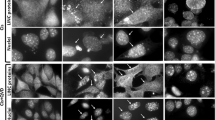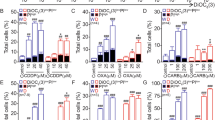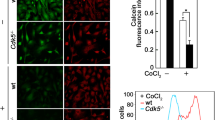Abstract
Apoptosis induced by DNA-damaging agents or radiation mainly proceeds through death receptor-independent caspase activation. The release of mitochondrial apoptogenic proteins, such as cytochrome c, into the cytoplasm leading to Apaf1-dependent activation of caspase-9 is a key event in this pathway. The permeability of the mitochondrial outer membrane is regulated by the various pro- and antiapoptotic Bcl-2 family proteins, and it is thought that DNA damage triggers apoptosis through the downregulation of antiapoptotic Bcl-2. Using murine embryonic fibroblasts (MEF) deficient and proficient in Apaf1, we show that DNA-damaging agents and radiation lead to a decline in Bcl-2 protein only in wt MEF, but not in apaf1−/− MEF, which are defective in the activation of effector caspases and apoptosis. In contrast, the induction of proapoptotic Noxa, the activation of Bax, the cytoplasmic release of cytochrome c, as well as a drop of the mitochondrial transmembrane potential Δψm are equally observed in wt and apaf1−/− MEF following DNA damage. Moreover, the loss of Bcl-2 protein occurring in wt MEF can be prevented by caspase inhibition. Hence, the activation of proapoptotic Bcl-2 family proteins rather than the downregulation of antiapoptotic Bcl-2 mediates the primary signal in the DNA damage-induced release of mitochondrial apoptogenic proteins in MEF.
This is a preview of subscription content, access via your institution
Access options
Subscribe to this journal
Receive 50 print issues and online access
$259.00 per year
only $5.18 per issue
Buy this article
- Purchase on Springer Link
- Instant access to full article PDF
Prices may be subject to local taxes which are calculated during checkout



Similar content being viewed by others
References
Bossy-Wetzel E, Newmeyer DD and Green DR . (1998). EMBO J., 17, 37–49.
Cecconi F, Alvarez-Bolado G, Meyer BI, Roth KA and Gruss P . (1998). Cell, 94, 727–737.
Chen M, Quintans J, Fuks Z, Thompson C, Kufe DW and Weichselbaum RR . (1995). Cancer Res., 55, 991–994.
Cheng EHYA, Wei MC, Weiler S, Flavell RA, Mak TW, Lindsten T and Korsmeyer SJ . (2001). Mol. Cell, 8, 705–711.
Deshager S, Osen-Sand A, Nichols A, Eskes R, Montessuit S, Lauper S, Maundrell K, Antonsson B and Martinou J-C . (1999). J. Cell Biol., 144, 891–901.
Dimmeler S, Breitschopf K, Haendeler J and Zeiher AM . (1999). J. Exp. Med., 189, 1815–1822.
Dunkern TR, Fritz G and Kaina B . (2001). Oncogene, 20, 6026–6038.
Finucane DM, Bossy-Wetzel E, Waterhouse NJ, Cotter TG and Green DR . (1999). J. Biol. Chem., 274, 2225–2233.
Fujita N, Nagahashi A, Nagashima K, Rokudai S and Tsuruo T . (1998). Oncogene, 17, 1295–1304.
Goldstein JC, Waterhouse NJ, Juin P, Evan GI and Green DR . (2000). Nat. Cell Biol., 2, 156–162.
Green DR . (2000). Cell., 102, 1–4.
Hakem R, Hakem A, Duncan GS, Henderson JT, Woo M, Soengas MS, Elia A, de al Pompa JL, Kagi D, Khoo W, Potter J, Yoshida R, Kaufman SA, Lowe SW and Mak TW . (1998). Cell, 94, 339–352.
Huang DCS and Strasser A . (2001). Cell, 103, 839–842.
Kirsch DG, Doseff A, Chau BN, Lim DS, de Sauza-Pinto NC, Hansford R, Kastan MB, Lazebnik YA and Hardwick JM . (1999). J. Biol. Chem., 274, 21155–21161.
Kuida K, Haydar TF, Kuan C-Y, Gu Y, Taya C, Karasuyama H, Su MSS, Rakic P and Flavell RA . (1998). Cell, 94, 325–337.
Kuwana T, Mackey MR, Perkins G, Ellisman MH, Latterich M, Schneiter R, Green DR and Newmeyer DD . (2002). Cell, 111, 331–342.
Lassus P, Opitz-Araya X and Lazebnik Y . (2002). Science, 297, 1352–1354.
Lindsten T, Ross AJ, King A, Zong W-X, Rathmell JC, Shiels HA, Ulrich E, Waymire KG, Mahar P, Frauwirth K, Chen Y, Wei M, Eng VM, Adelman DM, Simon MC, Ma A, Golden JA, Evan G, Korsmeyer SJ, MacGregor GR and Thompson CB . (2000). Mol. Cell, 6, 1389–1399.
Lowe SW, Ruley HE, Jacks T and Housman DE . (1993). Cell, 74, 957–967.
Marsden VS, O'Connor L, O'Reilly LA, Silke J, Metcalf D, Ekert PG, Huang DC, Cecconi F, Kuida K, Tomaselli KJ, Roy S, Nicholson DW, Vaux DL, Bouillet P, Adams JM and Strasser A . (2002). Nature, 419, 634–637.
Minn AJ, Kettlun CS, Liang H, Kelekar A, Vander Heiden MG, Chang BS, Fesik SW, Fill M and Thompson CB . (1999). EMBO J., 18, 632–643.
Miyashita T, Harigai M, Hanada M and Reed JC . (1994). Cancer Res., 54, 3131–3135.
Miyashita T and Reed JC . (1995). Cell, 80, 293–299.
Nakano K and Vousden KH . (2001). Mol. Cell, 7, 683–694.
Nechushtan A, Smith CL, Hsu Y-T and Youle RJ . (1999). EMBO J., 18, 2330–2341.
O'Connor L, Strasser A, O'Reilly LA, Hausmann G, Adams JM, Cory S and Huang DCS . (1998). EMBO J., 17, 384–395.
Oda E, Ohki R, Murasawa H, Nemoto J, Shibue T, Yamashita T, Tokino T, Taniguchi T and Tanaka N . (2000). Science, 288, 1053–1058.
Saito M, Korsmeyer SJ and Schlesinger PH . (2000). Nat. Cell Biol., 2, 553–555.
Schuler M, Bossy-Wetzel E, Goldstein JC, Fitzgerald P and Green DR . (2000). J. Biol. Chem., 215, 7337–7342.
Schuler M, Maurer U, Goldstein JC, Breitenbücher F, Hoffarth S, Waterhouse NJ and Green DR . (2003). Cell Death Differ, 10, 451–460.
Strasser A, Harris AW, Jacks T and Cory S . (1994). Cell, 79, 329–339.
Yoshida H, Kong Y-Y, Yoshida R, Elia AJ, Hakem A, Hakem R, Penninger JM and Mak TW . (1998). Cell, 94, 739–750.
Acknowledgements
We thank Dr Francesco Cecconi and Professor Peter Gruss for providing apaf1−/− and control MEF, Dr Scott W Lowe for retroviral plasmids, and Professor Christoph Huber for his support. Dr Kerstin Fabian and Professor Bernd Kaina are acknowledged for helpful discussions. This work was supported by a grant from the Max-Eder-Programm of the Deutsche Krebshilfe to MS (project no. 70-2952).
Author information
Authors and Affiliations
Corresponding author
Rights and permissions
About this article
Cite this article
Milosevic, J., Hoffarth, S., Huber, C. et al. The DNA damage-induced decrease of Bcl-2 is secondary to the activation of apoptotic effector caspases. Oncogene 22, 6852–6856 (2003). https://doi.org/10.1038/sj.onc.1206716
Received:
Revised:
Accepted:
Published:
Issue Date:
DOI: https://doi.org/10.1038/sj.onc.1206716
Keywords
This article is cited by
-
Receptor-Interacting Protein 140 Enhanced Temozolomide-Induced Cellular Apoptosis Through Regulation of E2F1 in Human Glioma Cell Lines
NeuroMolecular Medicine (2022)
-
Early-stage bilayer tissue-engineered skin substitute formed by adult skin progenitor cells produces an improved skin structure in vivo
Stem Cell Research & Therapy (2020)
-
Individual dose and scheduling determine the efficacy of combining cytotoxic anticancer agents with a kinase inhibitor in non-small-cell lung cancer
Journal of Cancer Research and Clinical Oncology (2012)
-
Effect of matrine on HepG2 cells: role of glutathione and cytochrome c
The Chinese-German Journal of Clinical Oncology (2008)
-
Mechanisms of thymidine kinase/ganciclovir and cytosine deaminase/ 5-fluorocytosine suicide gene therapy-induced cell death in glioma cells
Oncogene (2005)



